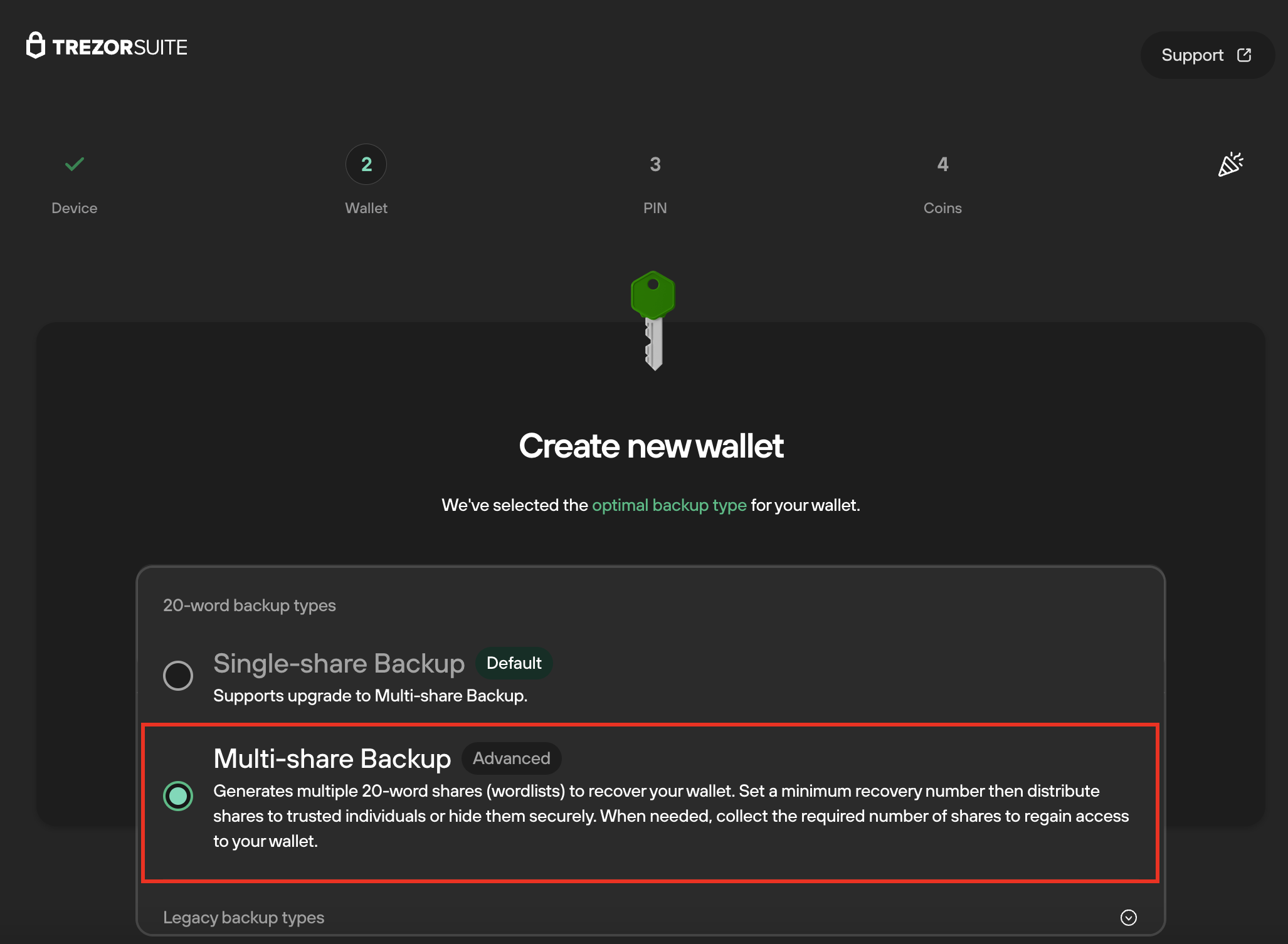Upgrading to Multi-share Backup
If you’ve decided it’s time to boost your personal security standards, adopting Multi-share Backup is a giant leap in achieving just that!
Depending on your current Trezor setup, there are different routes to getting set up with Multi-share Backup:
I have a brand new Safe 5, Safe 3 or Model T
If you're just unboxing a new Trezor that's compatible with Multi-share Backup, you can even bypass the upgrade process and dive straight in to a Multi-share setup. Select Multi-share Backup during the device initialization and follow the on-screen and on-device instructions:
I’m already using Single-share Backup on my Trezor
If you’re already setup your Trezor with a 20-word Single-share Backup, you can upgrade to Multi-share Backup directly via Trezor Suite settings:
- Go to Settings > Device
- Select Create Multi-share Backup:

- Follow the on-screen and on-device instructions.
I have a 12 or 24-word wallet backup with my Safe 5, Safe 3 or Model T
If you’re already using a 12 or 24-word wallet backup (recovery seed), the process is more complicated. As you will be migrating from one standard to another (i.e., BIP39 to SLIP39) your wallet will be set up using a different seed. This means you will have to migrate your funds carefully from one seed to another, which entails multiple steps.
The step-by-step process required for ‘indirectly’ upgrading from BIP39 to Multi-share Backup is as follows:
- Grab your original wallet backup and check it is valid by performing a dry run recovery
- Once you’ve confirmed your backup is correct, you can wipe your device:
- Set up your Trezor with a new Multi-share Backup
- Connect your wiped Trezor
- Install latest FW
- Select Multi-share Backup during device initialization and follow the on-screen and on-device instructions:

Now that you’ve created a Multi-share Backup (for a new seed) you can transfer the funds from your original seed to the new one. The steps for doing so are outlined in our Move crypto to a wallet with a new seed article.
I am already using Shamir Backup
To create additional Multi-share Backup(s) directly via Trezor Suite settings, you require either:
- A new 20-word Single-share Backup
- A new Multi-share Backup
If you have already set up a Shamir wallet prior to the June 2024 release of Trezor Suite, it is not possible to create additional Multi-share Backups via the Trezor Suite settings menu (as outlined above).
Each Multi-share Backup’s shares are unique and can’t be mixed with another Multi-share Backup. In this case, you will have two separate, valid Multi-share Backups, each usable only with their own set of shares respectively.
What happens to my Single-share Backup when I upgrade to a Multi-share Backup?
When you create a new Multi-share Backup from your 20-word Single-share Backup, you will create a new Multi-share Backup. You cannot add your Single-share Backup as part of a new Multi-share Backup.If you want to reduce the risk of having a single point of failure, you have the option of destroying the original Single-share Backup. You should only destroy your Single-share Backup after verifying your new Multi-share Backup works and that you can access your funds with it.
Similarly, when creating a new Multi-share Backup after you have already made a Multi-share Backup, you can only create a new backup. It is not possible to use backup shares interchangably. To check if a backup share belongs to a certain backup, you can always look at first two words in the backup share, as these will be consistent across all shares within a Multi-share Backup.